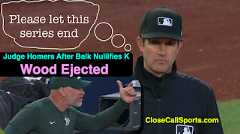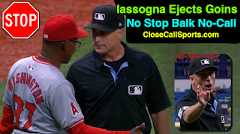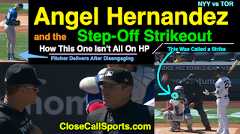2B Umpire Roberto Ortiz ejected Yankees RF José Caballero (Replay Review decision that upheld out call/pace of play/disengagement no-call; QOCY) in the top of the 10th inning of the #Yankees-#Rays game. With one out and none on, Yankees batter José Caballero attempted to steal second base during Aaron Judge's at bat, thrown out by Rays catcher Hunter Feduccia to second baseman Brandon Lowe and affirmed as an out (call stands) upon Replay Review as the result of a manager's challenge by Yankees manager Aaron Boone. Replays do not conclusively indicate whether Lowe tagged Caballero while he was off the base, the call was correct.* At the time of the ejection, the Yankees were leading, 6-3. The Yankees ultimately won the contest, 6-4, in 10 innings.
This is Roberto Ortiz (40)'s 5th ejection of 2025.
*Prior to the caught stealing, Caballero appeared to be awarded second base on a disengagement balk as a result of pitcher Pete Fairbanks throwing over to first base three times unsuccessfully during the same at-bat. However, replays indicate that after the second disengagement and pickoff attempt, 1B Umpire Ben May called "Time" to replace the baseball. As Fairbanks never re-engaged the pitcher's plate/rubber and thus HP Umpire Chad Fairchild never put the ball back into play, the ball never became live, the third "throw" did not legally occur, and, therefore there was no third "disengagement." Had R1 Caballero been "out" during the dead ball pickoff attempt, the out call would not have stood either.
Official Baseball Rule 5.12: "When an umpire suspends play, they shall call “Time.” At the umpire-in-chief’s call of “Play,” the suspension is lifted and play resumes. Between the call of “Time” and the call of “Play” the ball is dead."
OBR 5.12 continued: "After the ball is dead, play shall be resumed when the pitcher takes their place on the pitcher’s plate with a new ball or the same ball in their possession and the plate umpire calls 'Play.'"
This is the 135th ejection of the 2025 MLB regular season.
This is the 39th player ejection of 2025. Ejection Tally: 73 Managers, 23 Coaches, 39 Players.
This is New York's 13th ejection of 2025, 1st in the AL East (NYY 13; BOS, TOR 7; BAL 5; TB 4).
This is José Caballero's first career MLB ejection.
This is Roberto Ortiz's 5th ejection of 2025, 1st sinceAugust 12 (Don Kelly; QOC = N [Balls/Strikes]).
Wrap: New York Mets vs Washington Nationals, 8/20/25 | Video as follows:





























